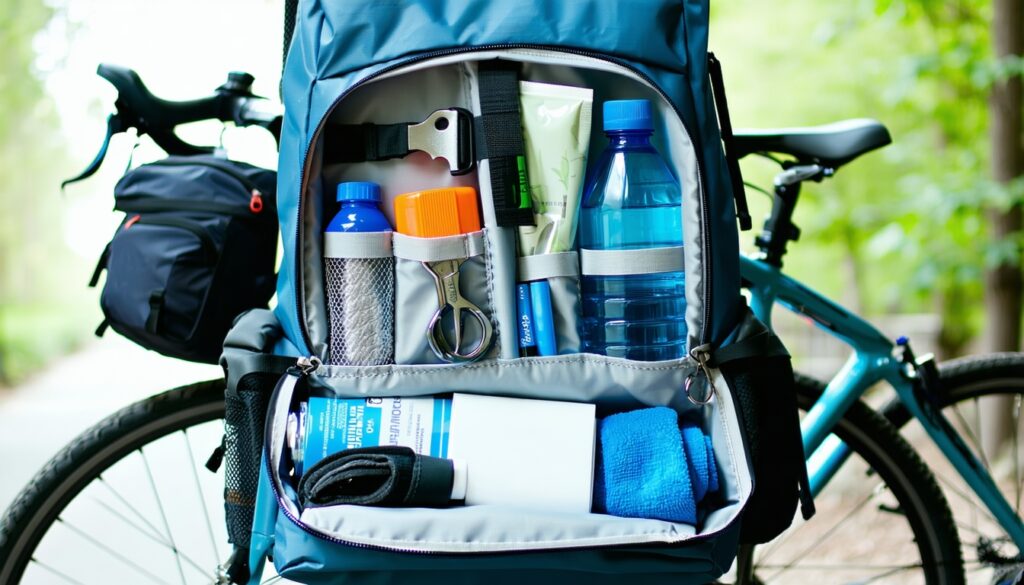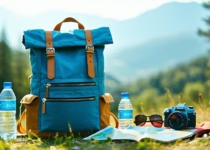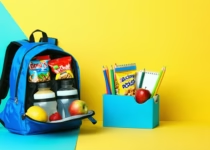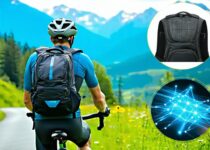Best Practices for Organizing Your Gear in a Bike Backpack

Types of Bikepacking Bags
When embarking on a bikepacking adventure, choosing the right bags is essential for comfort and efficiency. The bikepacking trinity consists of frame packs, half-frame packs, and handlebar bags, each serving unique purposes and offering various features.
Frame Packs
Frame packs are designed to fit within the triangular space of a bike’s frame, providing storage that ranges from three to nine liters. They are ideal for carrying heavier items such as food, tools, spare parts, cooking equipment, electronics, and water. Utilizing the frame’s low center of gravity helps maintain better bike handling during rides (Bikepacking.com).
| Feature | Detail |
|---|---|
| Capacity | 3 to 9 liters |
| Ideal for | Tools, food, cooking gear |
| Customization | Can be custom-made or in near-universal sizes |
Half Frame Packs
Half-frame packs capitalize on a portion of the frame triangle’s space. These versatile bags can be paired with water bottles or cargo cages, allowing for extra flexibility in packing. Half-frame packs are light and efficient, making them suitable for carrying essential items while maintaining balance on the bike. They help maximize available space without overwhelming the bike’s dynamics.
| Feature | Detail |
|---|---|
| Capacity | Varies, generally lighter than full-frame packs |
| Ideal for | Snacks, small tools, personal belongings |
| Compatibility | Works well with water bottles or other cargo |
Handlebar Bags
While handlebar bags may not be the most efficient for gear storage, they provide convenient access during bikepacking trips. Recommended for lighter items like ultralight camping gear, tents, sleeping bags, or clothing, handlebar bags help maintain a light front load, which improves bike handling.
Different types of handlebar bags include handlebar rolls, harnesses, and top-loaders, each offering specific features that cater to the rider’s needs.
| Feature | Detail |
|---|---|
| Purpose | Easy access to lightweight gear |
| Types | Handlebar rolls, harnesses, top-loaders |
| Ideal for | Ultralight camping gear, clothing |
Choosing the right combination of these bags can lay the groundwork for successful and enjoyable bikepacking trips. Proper organization and efficient packing can make all the difference as cyclists hit the trails or roads. For more tips on effectively utilizing your bike backpack, check out our guide on how to pack tools, snacks, and gear in a bike backpack.
Essential Considerations for Organizing Gear
When it comes to best practices for organizing your gear in a bike backpack, there are several essential considerations to keep in mind. Whether you are embarking on a short ride or a long bikepacking adventure, these factors will help ensure a pleasant cycling experience.
Weight Distribution
Balancing the weight of gear around the bike’s center of gravity is crucial for a comfortable ride. Carryology emphasizes that different spaces on the bike serve specific purposes for storing items. Proper gear distribution contributes to maintaining balance and ride feel.
Here is a simple guide for weight distribution:
| Item Type | Recommended Location |
|---|---|
| Heavy Items | Frame Packs |
| Spare Clothes | Saddle Bags or Top Tube Bags |
| Food and Snacks | Handlebar Bags or Pouches |
| Easy Access Items | Top Tube Bags |
Water Management
Having a functional water management system can make a significant difference during rides. Waterproof and durable bikepacking bags are essential for keeping gear dry. Features such as seam welding, waterproof zips, roll closures, zipper garages, and flaps that divert water are highly recommended.
Riders should ensure proper hydration by considering the following:
| Water Management Method | Description |
|---|---|
| External Water Bottles | Easy access during the ride |
| Hydration Bladder | Maintains space efficiency |
| Waterproof Bags | Keeps gear dry in wet conditions |
For those looking to ensure they stay hydrated on rides, reviewing our article on hydration-compatible cycling backpacks: what to look for might be beneficial.
Electronics Charging
With the increasing reliance on electronics for navigation and communication during rides, having a reliable charging solution is essential. Cyclists should look for backpacks that come with built-in USB charging ports, allowing them to keep devices powered without hassle.
When organizing for electronics charging, consider:
| Charging Feature | Benefits |
|---|---|
| Built-in USB Ports | Convenient device charging while riding |
| Portable Battery Packs | Extra power sources for extended trips |
| Quick Access Pockets | Safely storing and charging devices |
Ensuring that electronic devices stay charged and accessible can greatly enhance the riding experience. For more on this topic, check our article on the best cycling backpacks with built-in USB charging ports.
By following these considerations, cyclists can create a well-organized backpack, enhance their riding experience, and ensure they are prepared for any situation that arises during their journey.
Gear Essentials for Bikepacking
When preparing for a bikepacking adventure, having the right gear is vital for both safety and efficiency. Below are the essential items every cyclist should consider when organizing their gear in a bike backpack.
Navigation Tools
Navigating during a bikepacking trip can make or break the experience. It is critical to have reliable navigation tools. Essential navigation items include:
- GPS Device: Provides real-time tracking and route information.
- Physical Maps: Always a good backup in case of technology failure.
- Compass: A simple and reliable tool for directional guidance.
| Navigation Tool | Importance |
|---|---|
| GPS Device | Provides real-time tracking |
| Physical Maps | Serves as a backup |
| Compass | Offers reliable directional help |
For those looking to enhance their experience, consider exploring lightweight bikepacking backpacks for short trips that allow easy access to navigation tools.
Repair Kit and Safety Gear
Having a repair kit is essential for dealing with any mechanical issues that might arise on the road. Each kit should ideally include:
- Tire Levers: Help in removing tires during repairs.
- Multi-tool: A Compact tool for various repairs.
- Spare Tubes: Essential for puncture repairs.
- Patch Kit: For quick fixes on the go.
Safety gear is equally important. Cyclists should ensure they have:
- Helmet: Protects the head in case of an accident.
- Lights: Improves visibility during low-light conditions.
- Reflective Gear: Enhances visibility to others.
- First-Aid Kit: Helpful for treating minor injuries.
| Repair Kit Item | Purpose |
|---|---|
| Tire Levers | Tire removal |
| Multi-tool | Various repairs |
| Spare Tubes | Puncture replacements |
| Patch Kit | Quick on-the-go fixes |
| Safety Gear Item | Purpose |
|---|---|
| Helmet | Head protection |
| Lights | Enhances visibility |
| Reflective Gear | Increases safety |
| First-Aid Kit | Treat minor injuries |
For insights on product selection, check out our guide on how to pack tools, snacks, and gear in a bike backpack.
Bike Frame and Tire Considerations
Choosing the right bike frame and tire configuration is crucial for a successful bikepacking journey. Key considerations include:
- Frame Material: Opt for lightweight materials like aluminum or carbon for efficiency.
- Tire Width: Wider tires provide better traction and stability on various terrains.
- Bike Rack: If transporting your bike, a sturdy bike rack is essential to ensure safety.
| Component | Recommendation |
|---|---|
| Frame Material | Aluminum or carbon for lightweight efficiency |
| Tire Width | Wider for better traction |
| Bike Rack | Essential for transporting the bike safely |
Explore additional details on specific bike types in our article on cycling backpack vs rack pannier: pros & cons.
Each of these gear essentials plays a significant role in ensuring a smooth, enjoyable bikepacking experience. With careful organization in a bike backpack, cyclists can venture confidently into their adventures.
Efficient Packing Strategies
Packing effectively for bikepacking ensures comfort and efficiency on the ride. Utilizing the right strategies can make all the difference in the cycling experience.
Prioritizing Essentials
When preparing for a bikepacking trip, prioritizing essential gear is vital. Key essentials include:
- Clothing for Riding: Comfortable and appropriate clothing, depending on weather conditions.
- Cycling Accessories: Items such as gloves, glasses, and a helmet will enhance safety and comfort.
- Electronics: Navigation devices and chargers to stay connected and on route.
- Water and Food: Hydration packs or water bottles and non-perishable snacks.
- Camping Supplies: Lightweight tents, sleeping bags, and cooking equipment.
- Safety Equipment: First aid kits and multi-tools for bike repairs.
- Tools with Spare Parts: Essential tools for basic bike malfunctions, ensuring self-sufficiency on the road.
Stripping down your kit to just these essentials helps maintain a manageable load, allowing for a more enjoyable ride. Remember that in bikepacking, less is often more.
Balancing Weight
Achieving proper weight distribution is crucial for a smooth cycling experience. Balanced weight around the center of gravity of the bike enhances stability.
| Packing Strategy | Recommended Bags |
|---|---|
| Front Weight | Handlebar rolls |
| Center Weight | Frame bags |
| Rear Weight | Saddle packs |
Pack heavier items close to the frame to lower the center of gravity, minimizing the risks of tipping or losing control. Using various bikepacking bags helps distribute the weight evenly, avoiding a lopsided experience. Doing so also makes it easier to maneuver on challenging terrains.
Avoiding Overpacking
Overpacking is a common challenge for cyclists. Carrying unnecessary items not only adds extra weight but can also make the ride uncomfortable. To avoid this, riders should focus on carrying only what is needed. Ask these questions to assess each item:
- Is this essential for my ride?
- Will I really use this?
- Can I find a substitute that is lighter or more compact?
By thoughtfully evaluating gear and keeping to the essentials, cyclists can prevent clutter and carry only what they need. For more tips on packing efficiently, check out our article on how to pack tools, snacks, and gear in a bike backpack.
Proper planning, balanced weight distribution, and smart packing are best practices for organizing your gear in a bike backpack. This approach leads to a more enjoyable and successful bikepacking adventure where the focus can remain on the ride rather than the luggage.
Strategies for Perfect Balance
Achieving perfect balance in a bike backpack is essential for a comfortable cycling experience. This involves utilizing space effectively, distributing gear wisely, and ensuring that bags are waterproof to protect against the elements.
Space Utilization
When organizing gear in a bike backpack, using space efficiently is crucial. Full-frame bags can occupy the entire frame triangle, providing maximum packing volume. Custom-made frame bags are ideal for ensuring a perfect fit with various bike frame designs. Universal-fit options are also available, such as those from Revelate Ranger and Rockgeist 52Hz.
Here’s a breakdown of different areas on a bike where bags can be placed and their respective purposes:
| Bag Type | Purpose |
|---|---|
| Frame Bags | Spare clothes, heavy items |
| Handlebar Bags | Easy-access items, food |
| Saddle Bags | Sleeping gear, bulky items |
| Top Tube Bags | Snacks, tools for quick access |
| Fork Bags | Lightweight gear, tools |
Gear Distribution
Efficient gear distribution around the bike’s center of gravity is essential for maintaining balance. Items should be packed based on their weight, with heavier items placed closer to the bike frame to lower the center of gravity. This positioning helps stabilize both the bike and the rider. It’s advisable to avoid cramming all gear into one bag, as this can lead to an uneven weight distribution that may affect riding quality.
Riders should include only the essential tools and spares needed for self-support, such as spare tires and multitools. Avoiding bulky, unnecessary items can result in a more enjoyable ride.
Waterproofing Bags
Ensuring that packs are waterproof is vital for any bikepacking trip. Wet gear can quickly ruin an adventure. Using bags with features such as seam welding, waterproof zips, and roll closures can significantly improve water resistance. Here are key elements to look for in waterproofing:
| Waterproof Feature | Description |
|---|---|
| Seam Welding | Creates a solid barrier against water intrusion |
| Waterproof Zips | Prevents water from seeping through zippers |
| Roll Closures | Creates a secure top seal that keeps water out |
| Zipper Garages | Additional flaps divert water away from zipper areas |
By focusing on space utilization, effective gear distribution, and waterproofing, cyclists can enhance their bikepacking experience while ensuring that the essentials are organized properly. For more information on packing strategies, see our article on how to pack tools, snacks, and gear in a bike backpack.


